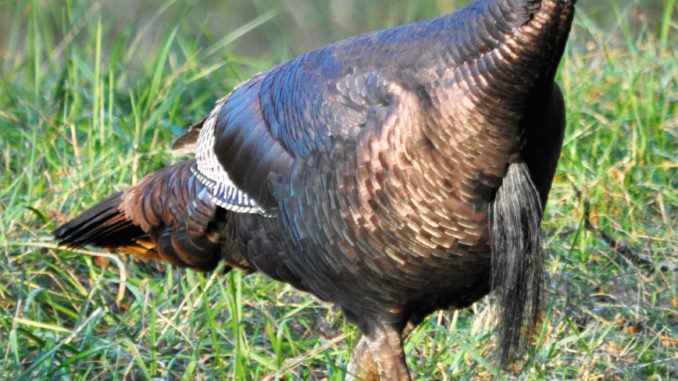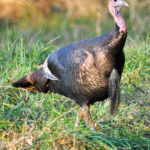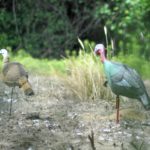
Unique habitat, smart birds add up to an interesting battle between hunters and gobblers.
Perhaps nowhere in North Carolina have wild turkeys fared better than the state’s northeastern quadrant.
For years, the counties along the Roanoke River drainage — Bertie, Halifax, Martin and Northampton — have been among leaders in turkey harvests.
The region, including private and public land, features several advantages for the birds, not the least of which is relatively few human occupants. Also, many residents are farmers who cultivate large fields that grow agricultural crops and provide food for turkeys. Swampy habitats around fields also offer safe roosting and escape areas, but perhaps most important, landowners have protected the birds.
The Roanoke River Wetlands and National Wildlife Refuge Game Lands, spread along either side of the river in the four counties, also provide an almost de facto sanctuary for wild turkeys. Hunting is allowed but by permit only, which reduces pressure on longbeards.
One hunter who recognizes the Roanoke River drainage as a pot of gold for turkey hunters is 40-year-old Clark Purvis of Hobgood, a stone’s throw from the river in the southeastern corner of Halifax County.
An East Carolina University graduate, Purvis opened his own guide service, Roanoke River Waterfowl, in 2007, specializing in waterfowl and turkey hunts, plus striped bass fishing. He has access to guide on several prime tracts of land, but he doesn’t often chase turkeys on them.
“I started guiding when I was 19 years old. I’ve hunted from around home to the Roanoke River Refuge to Maryland’s Eastern Shore,” he said. “One of my favorite places to go for wild turkeys is the Roanoke River Refuge.”
Purvis recognizes that the habitat along the river drainage makes chasing longbeards different from other areas of North Carolina. Most fields are flat, and some are huge, covering 100 or more acres. The soil is black loam, given to growing excellent yields of various agricultural crops.
But Purvis said the real difference is the birds themselves.
“The thing about hunting native Roanoke (River) valley birds is, they’ve always been there, so they’re a little sharper than turkeys you hunt at other parts of the state,” said Purvis, who recognized that the N.C. Wildlife Resources Commission stocked turkeys almost 20 years ago, then put most counties off-limits to hunting for several years to give birds a chance to expand their numbers..
“But the wild turkeys around here, ones that weren’t trapped, they have been in this environment where there’s always been a lot of hunting pressure,” Purvis said. “I just think they’re a little sharper than turkeys in other parts of the state. They grew up where people always hunted them.
“It’s almost the same situation you find in South Carolina or Georgia, where I’ve also hunted. South Carolina’s always had wild turkey hunting, and I think that’s what’s made (their) turkeys sharper, all around, than North Carolina turkeys.”
Habitat is, however, a key factor comparing turkeys in Northeastern North Carolina with Piedmont or mountain birds. Although much land along the river has been reclaimed for agricultural uses, most of it is black earth surrounded by swamps, pine forests or cutovers. Most old-growth, bottom-land hardwoods were timbered long ago, or farmers cleared the land for crops or pastures. That left turkeys with mostly low lands as roosting spots.
“The birds roost in trees in swamps or at low-ground places with trees, so it’s difficult to get near them to set up and call,” said Purvis (252-314-6865). “Swampy land gives them good protection, because it’s usually either wet or very dense with vines and tangles, so it kind of discourages people from going in.”
After daybreak, however, turkeys often will glide out of their roost trees and land in fields to hunt for food or mingle. That’s when scouting offers hunters an advantage, as they can determine where to set up to ambush birds, especially around field edges. Farmers usually don’t cultivate the perimeters of fields, and these places quickly grow up in small bushes, briars and weeds. Not only do field edges offer places to hide from wild turkeys, they’re where hens often build nests and lay eggs each spring.
The exception to the habitat rule of swampy roosting areas is land that’s been protected, mainly the game lands along the river.
The counties on the northern side of river contain National Wildlife Refuge land, while counties on the southern side include Commission-managed land.
“There are lots of open, bottomland hardwood forests along the river’s edges, particularly on the north side of the Roanoke River at the refuge,” Purvis said. “The turkeys typically roost near the river and fly down to open areas. That’s where you have the best luck. But on private land where they have planted chufa, that’s where turkeys also come after they fly down. Having chufa food plots to hunt really helps.”
Chufa might be unknown to many people, however, for wild turkeys and hunters, it is the holy grail of food plots. Its roots produce small tubers with a sweet, nut-like taste, and birds will travel extensively for chufa and will scratch in the ground until they’ve uncovered the last plant.
North Carolina’s largest chufa-growing operation is operated by Donnie Lassiter. He sells Cypress Knee Chufa from his family’s Northampton County farm.
“A lot of individuals, preserves and hunt clubs buy chufa from Donnie and plant food plots for turkeys,” Purvis said.
While scouting areas with chufa fields, Purvis said it’s not unusual to spot flocks of 50 or more birds , a definite boost to a hunter’s confidence — even if most of those large flocks contain mainly hens, jennies and jakes. Before the spring mating urge dictates their daily activities, mature gobblers spend most of their time in bachelor groups, feeding and roosting separately.
“But you know when you see a lot of hens, there’ll be gobblers nearby during the season, so seeing big numbers of turkeys is always a good sign,” Purvis said.
He uses three main techniques to find, hunt and kill wild gobblers — scouting, blinds and strategic ambushes.
“A lot of the time I make blinds and hunt at fields, especially if I’ve patterned turkeys and know they’re coming to certain fields,” Purvis said.
If he’s hunting along a field edge in a blind — either a pop-up blind or one he’s constructed from small bushes or simply a hiding place in thick brush — Purvis uses decoys.
“Normally, I put out a jake and a hen decoy,” said Purvis, whose favorite hen decoys are the Flambeau 3-point Flocked Hen and Shady Lady. “Their feathers look real, and the sun doesn’t reflect off them. They look better than foam decoys.”
Old gobblers are jealous of jakes and can’t tolerate a year-old male bird near a lone hen. Often, they’ll come running when they spot a decoy duo.
“But my favorite way to hunt is to move around, listen for a gobbler, then try to get between him and hens,” Purvis said.
That might seem to be a difficult task for most hunters, but in lowlands along the Roanoke, the tactic is simple yet effective.
“Hens are usually going to be at fields, and you don’t even have to see a hen,” Purvis said. “If a turkey’s gobbling on a swamp roost, before it gets light, you ease into the woods far enough off the field so any hens can’t see you and you’re not too close to the gobbler.”
If a gobbler is close and “hammers back” at him, Purvis said he often eschews setting up decoys because movement risks being detected.
But if he’s got time and distance, Purvis usually sets an ambush at least 200 yards from a roosting, gobbling bird. From that far, he often can entice a hot swamp donkey.
“Then it’s just a matter of not calling too much or too loudly, being patient and waiting on him to come,” Purvis said.






Be the first to comment